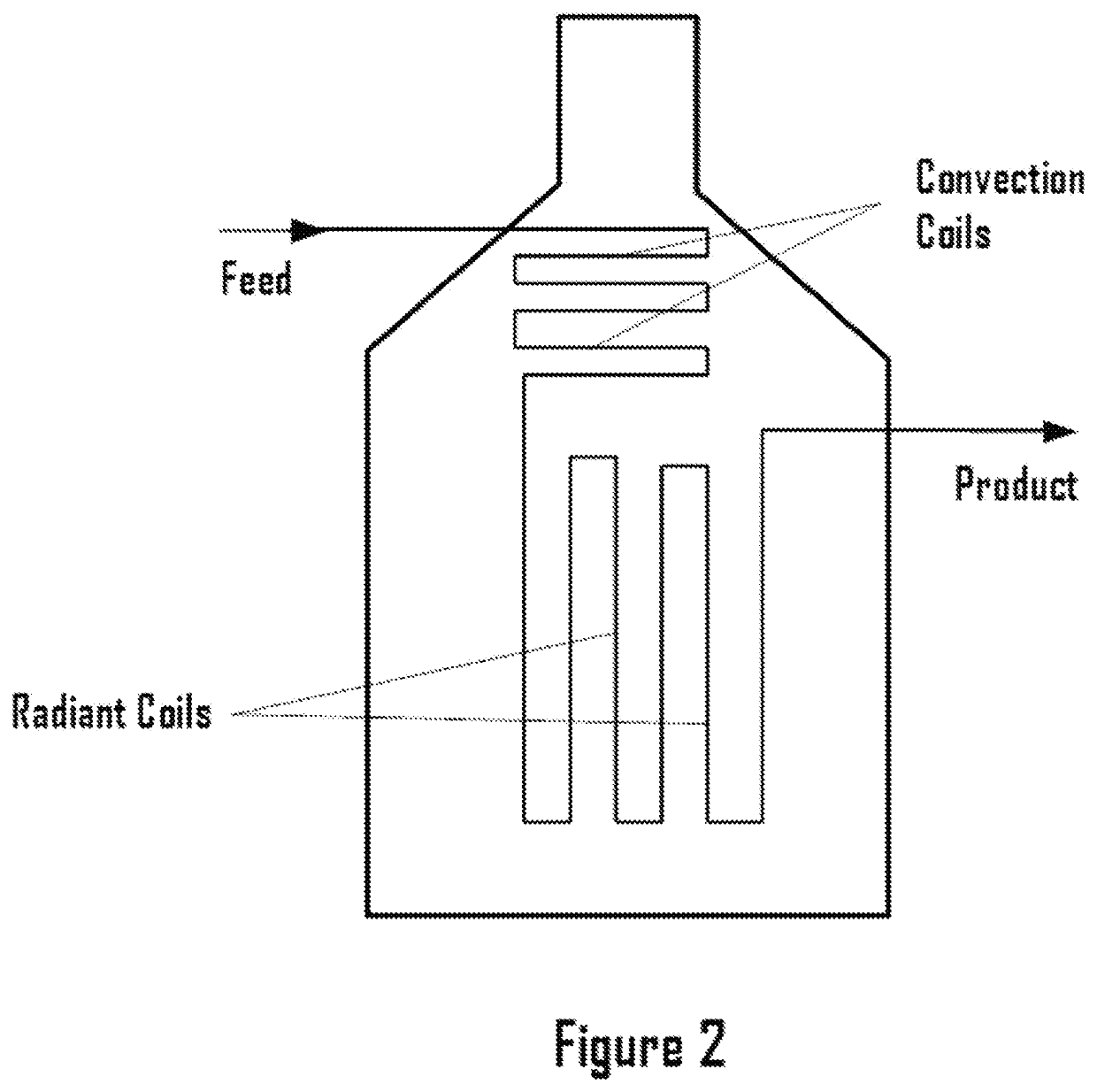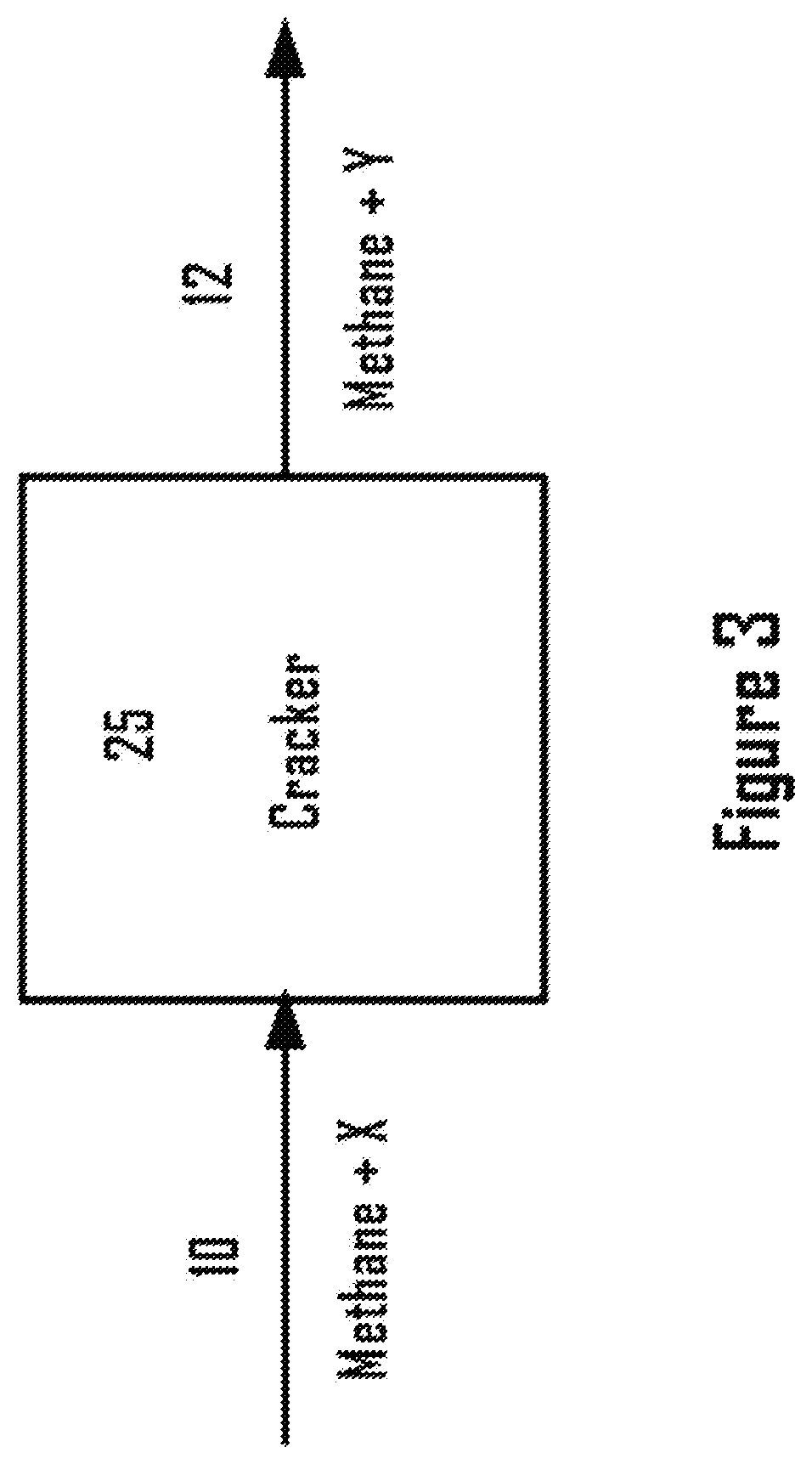Methane ethane crackers
a technology of methane ethane and crackers, which is applied in the field of system and process dehydrogenation, can solve the problems of capital and operating costs associated with the process, process complexity and cost, and achieve the effect of eliminating complexity and expense for steam generation, enhancing the rate of desired reactions, and suppressing undesired reactions in the cracker
- Summary
- Abstract
- Description
- Claims
- Application Information
AI Technical Summary
Benefits of technology
Problems solved by technology
Method used
Image
Examples
example 1
[0067]Equilibrium conversions of ethane to ethylene at the cracker temperatures of 850° C. and pressure of 2.2 atm were obtained under different conditions using Aspen Plus to perform the equilibrium calculations. It should be noted that equilibrium conversion is a reflection of the potential of a process in terms of its achievable maximum conversion for a given set of operating conditions. The higher the equilibrium conversion, the higher the actual paraffin conversion that can be achieved per pass through the cracker. Table 2 provides equilibrium conversions for a pure ethane feed, a conventional steam ethane cracker feed and various mixtures with different methane to ethane mole ratios at a temperature of 850° C. and pressure of 2.2 atm.
TABLE 2Feed RatioEquilibrium ConversionPure Ethane72.7%0.35 Kg Steam / 1 Kg Ethane76.4%0.5 Mol CH4 / 0.5 Mol C2H678.5%0.6 Mol CH4 / 0.4 Mol C2H680.7%0.7 Mol CH4 / 0.3 Mol C2H683.5%0.8 Mol CH4 / 0.2 Mol C2H687.3%0.9 Mol CH4 / 0.1 Mol C2H692.5%
[0068]It should b...
example 2
[0070]Table 3 shows equilibrium conversion of ethane for a thermal cracker operating at a temperature of 850° C. and pressure of 5 atm. It is observed that at a higher operating pressure of 5 atm, the feeds to the cracker with 80 mol % methane and 90 mol % methane have promises to provide same or even higher level of ethane conversion per pass as the conventional steam cracker case operating at 2.2 atm and same temperature (Table 2). Clearly, the use of methane enables the use of higher pressures while retaining comparable or achieving better conversions of ethane compared to the steam cracker operating at lower pressures.
TABLE 3Feed RatioEquilibrium ConversionPure Ethane57.4%0.35 Kg Steam / 1 Kg Ethane61.3%0.8 Mol CH4 / 0.2 Mol C2H675.7%0.9 Mol CH4 / 0.1 Mol C2H684.6%
example 3
[0071]Table 4 shows equilibrium conversion of ethane to ethylene for a thermal cracker operating at a temperature of 850° C. and pressure of 15 atm. Even under such a high pressure of operation, with 90 mol % of methane in the feed to the cracker, reasonable conversion of ethane can be obtained. Note the predicted relatively poor performance of a steam cracker operating at same temperature of 850° C. and pressure of 15 atm with 0.35 kg steam / 1 kg ethane.
TABLE 4Feed RatioEquilibrium ConversionPure Ethane37.48%0.35 Kg Steam / 1 Kg Ethane40.0% 0.8 Mol CH4 / 0.2 Mol C2H652.97%0.9 Mol CH4 / 0.1 Mol C2H665.34%
PUM
| Property | Measurement | Unit |
|---|---|---|
| pressure | aaaaa | aaaaa |
| temperature | aaaaa | aaaaa |
| residence time | aaaaa | aaaaa |
Abstract
Description
Claims
Application Information
 Login to View More
Login to View More - R&D
- Intellectual Property
- Life Sciences
- Materials
- Tech Scout
- Unparalleled Data Quality
- Higher Quality Content
- 60% Fewer Hallucinations
Browse by: Latest US Patents, China's latest patents, Technical Efficacy Thesaurus, Application Domain, Technology Topic, Popular Technical Reports.
© 2025 PatSnap. All rights reserved.Legal|Privacy policy|Modern Slavery Act Transparency Statement|Sitemap|About US| Contact US: help@patsnap.com



